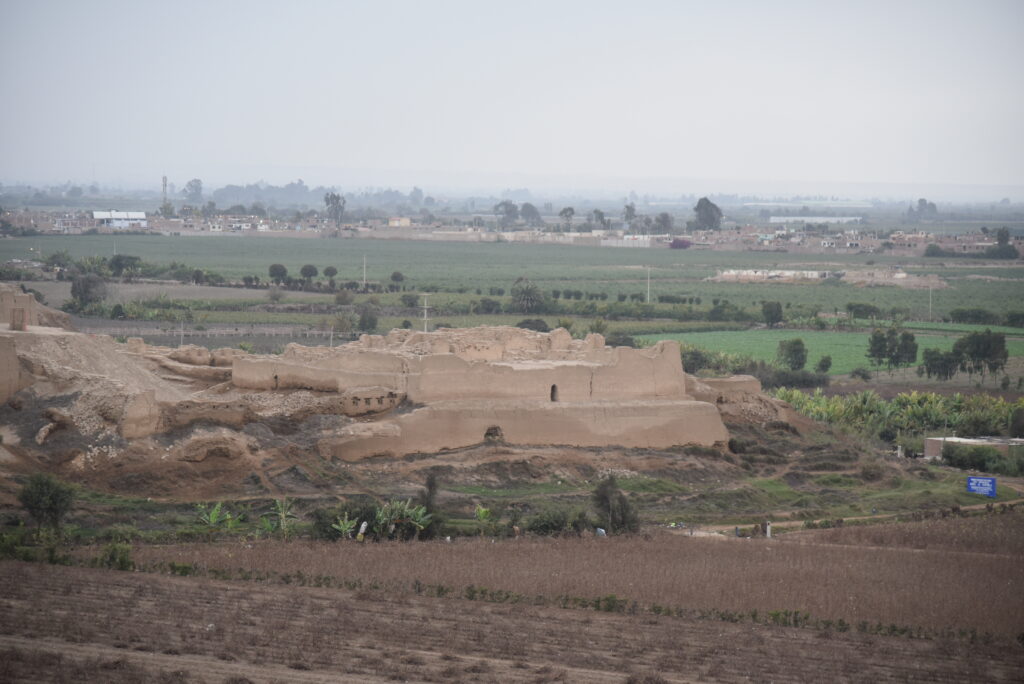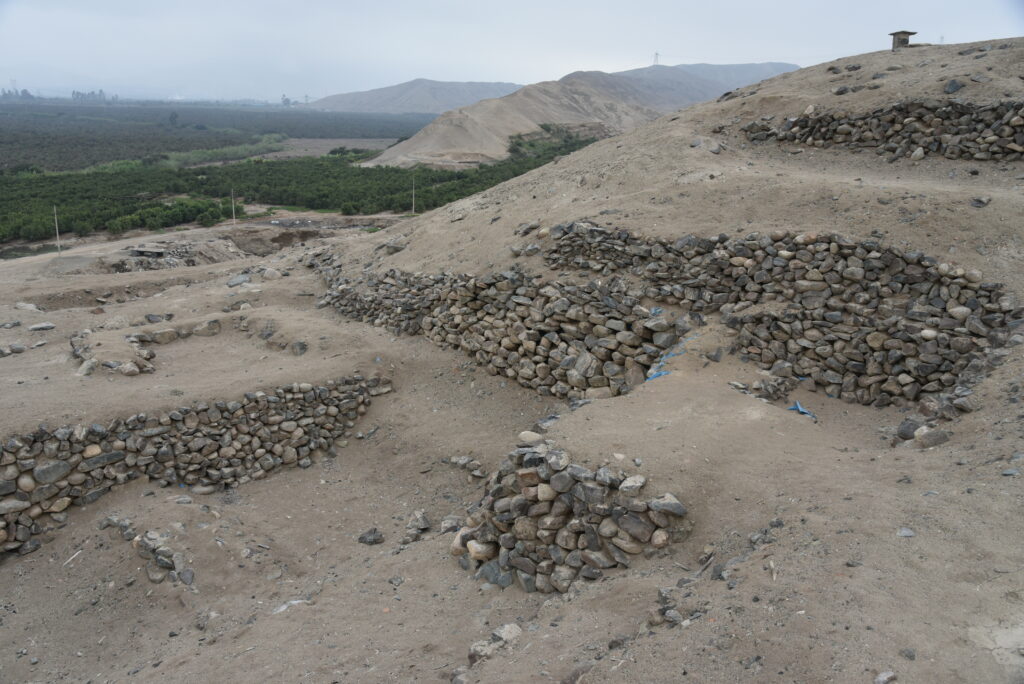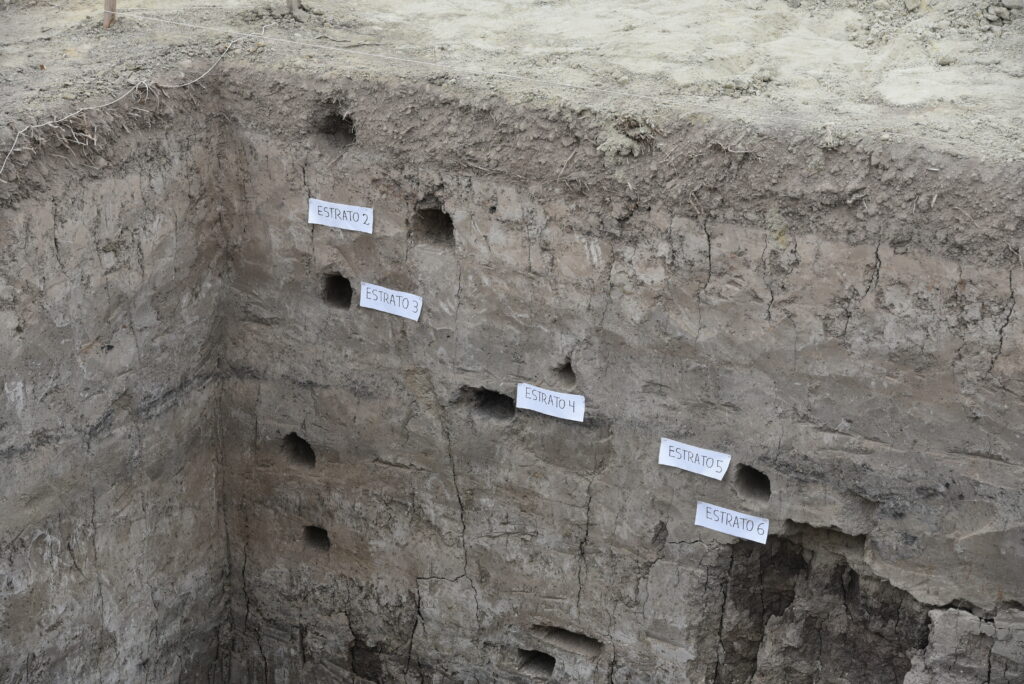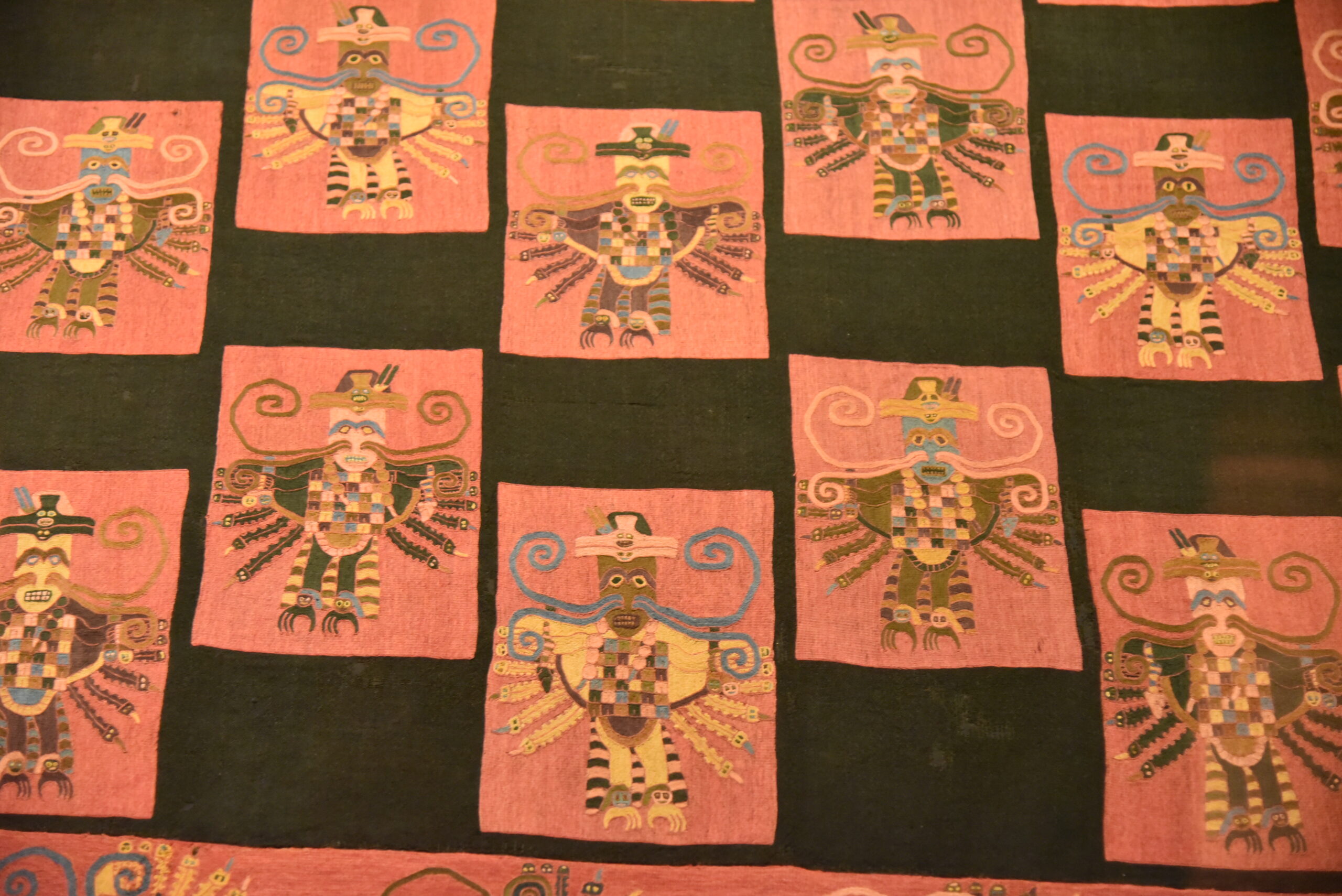Dry, desolate, and nearly uninhabited, the Paracas peninsula juts into the Pacific Ocean on Peru’s south coast. Since at least the nineteenth century, the peninsula was known as the site of ancient tombs. Looters would pillage its graves and sell the dusty textiles they unearthed to antiquities dealers.
But when Peruvian archaeologist Julio C. Tello began excavations there in 1925, he was nevertheless astonished by what he found. Digging in places the looters had missed, in an area known as Cerro Colorado, Tello turned up two huge groups of graves. One group, which he called Cavernas because its long underground passageways resembled caves, contained mummies wrapped in earth-colored weavings surrounded by hundreds of ceramic jars decorated with animal forms. In the other, located about a mile away, which he called the Necropolis, there were few ceramics, but hundreds of vibrantly colored weavings made of vicuña and llama wool, cotton, tropical bird feathers, and human hair. Some textiles featured flying humanoids clutching knives, grinning as snakes crawled out of their mouths. Others depicted bird and fish deities, flowers, and bold, abstract patterns, or men in elaborate headdresses and tunics and holding decapitated heads by their hair. A few were as large as dining room tables.
Although Tello usually wrote dispassionately about his finds, he marvelled that the Necropolis textiles he had unearthed had “the most beautiful and complicated mythological figures … and constitute the most magnificent examples” of ancient South American weaving. When unwrapped, the mummy bundles were found to contain the bones and the leathery, desiccated flesh of men and women whose skin had been preserved by the desert air of Paracas, a Quechua word meaning “sandstorm.” Some were so well preserved that Tello said he thought he could make out their facial expressions. Most were high-status priests or dignitaries, he concluded, although there were also some more humble burials he speculated might have been those of their attendants in the afterlife.
Tello believed that the Necropolis textiles dated to the late first millennium B.C., while the Cavernas ceramics were a few centuries older. Radiocarbon tests conducted decades later roughly confirmed his estimates and showed that the finest textiles dated from about 200 B.C. to A.D. 100, a time when, wrote Tello, people along the southern coast developed weaving “to an extraordinary degree.” He noted, too, that the peninsula had no fresh water or arable land. The graves contained plentiful offerings of food for the dead, including gourds and corn, but he could locate no land suitable for farming for at least 10 miles. “There is a marked contrast between the presence of highly developed cultures and the absolute absence of the basic elements of life,” he wrote.
Since their discovery, the Paracas tombs have been celebrated for their textiles, 429 of which Tello and his team excavated and sent to Lima’s National Museum of Archaeology, Anthropology, and History of Peru (MNAAHP), where most remain today. The mystery of where the people who created them actually lived made them the subject of intense fascination. In the decades after Tello worked in Paracas, archaeologists searched dozens of sites up and down the south coast, unearthing ceramics that bear stylistic similarities to those from the Paracas burials, but the relatively few textiles they found were far humbler than the Necropolis’ galaxies of color. None of the sites they excavated seemed to offer definitive evidence of a place for the living, only for the dead.
In the last few years, however, by digging deeper than anyone has before —as much as 20 feet down in some places — archaeologists Charles Stanish of the University of South Florida and Henry Tantaleán of the National University of San Marcos believe they have found where the textile weavers made their homes. The team has excavated at four major ancient mounds, among a total of 21 located near the modern town of Chincha, on a wide coastal plain about 25 miles north of where the Paracas Peninsula meets the mainland. There they have unearthed dozens of ancient weaving tools and pounds of cotton plant remains, wool, and imported feathers. Given the combination of these large mounds and the discovery of remains of extensive irrigation systems dating from as far back as 1100 B.C., as well as abundant evidence of textile and ceramic production in and around Chinchua, Stanish says evidence is accumulating that this was the main settlement area of what is now known as the Paracas culture, a name that commemorates the place where these people buried their most prized creations. “The sample we have is still small, but this does seems to be where they lived,” says Stanish. “I think we have established that Chincha was the capital of Paracas.”

Beginning sometime before 3000 B.C., the ancestors of the Paracas people who would eventually bury their high-status dead on the peninsula fished and farmed this coastal plain, where rivers wash down from the Andes. In fact, the high level of sedimentation in the Chincha area that has made digging there so difficult was likely caused by deforestation for intensive agriculture on the valley’s upper slopes in the pre-Paracas period. Local residents made simple, unadorned, unfired ceramics, and around 1100 B.C., says Stanish, they began constructing tall mudbrick platforms with long, thick walls and solid floors. According to the archaeologist Ann Peters of the University of Pennsylvania Museum of Archaeology and Anthropology, these platforms are distributed across the agricultural areas of the Chincha Valley, and the Paracas people positioned them to line up with solar phenomena that would tell them when to plant and when to harvest. The mounds grew larger and larger over the course of the first millennium B.C. and became places where people would gather for major festivals that were probably tied to growing cycles.
These platforms, as well as the irrigation canals, would have required large groups of well-organized, well-fed workers to construct, which Stanish sees as evidence of a centralized authority capable of marshaling people, either through consensus or coercion. The Paracas people probably lived in a loose confederation of small, localized states that shared a common but not identical culture. Around 800 B.C. they were swept up in a new cultural order originating at a pilgrimage site in Peru’s northern mountains called Chavín. Whether that new order arrived as a result of mass migration, conquest, or by some other means is unclear, but Chavín left a deep imprint on how the Paracas people worshipped. They developed a taste for pilgrimage, and they took up the new technology of fired ceramics, too. People traveled to Chavín from all over the Andes to practice a prophetic religion based on semi-mythical animals and cosmic mysteries mediated by priests. While Chavín-style pottery in the Chincha Valley began simply and was at first decorated with basic designs, within a few centuries the Paracas people began to use the wild imagery associated with later Chavín pottery created elsewhere in Peru and to cover their pots with felines, snake, and monkeys native to the Amazon jungle.
At the Pozuelo mound, 12 miles south of the city of Chincha, which dates to the beginning of the first millennium BC, Tantaleán excavated pottery that shows the early influence of Chavín at a time when fired ceramics were just starting to be made in this area. By 400 BC, that simply pottery had evolved into the sort of luxuriantly black, burnished pots with depictions of snarling jaguars, monkeys, and fanciful sea creatures of the type that Tello found in Cavernas. “The Chavín religion rested on the idea of pilgrimage and shamans who could manipulate the hidden forces that people believed controlled the universe,” says Tantaleán. “It was a very powerful cosmological vision and the Paracas people embraced it in their objects.”

The mastery of textiles that reached its apogee in the weavings of the Necropolis tombs in Paracas began at places such as Pozuelo. In a few trenches they dug at Pozuelo in 2019, Stanish and Tantaleán unearthed more than 20 small rings known locally as piruros, or spindle whorls, that Peruvians even today use for weaving. Small etched animal bones worn from use may that may also have been weaving tools.
Although these recent excavations have provided new information about how the Paracas people farmed, worshipped, and crafted their textiles, archaeologists have found hardly any domestic structures and little information about how, or even where, they spent their daily lives or where ordinary people buried their dead. Stanish and Tantaleán have identified few human remains in the mounds, and those that they have found appear to be sacrificial victims killed during ceremonies. And although there are signs that people inhabited the ceremonial mounds in the final century of the Paracas culture, around A.D. 100 to 200, the buildings were made of perishable materials that have long since disappeared.
Each of the mounds once had a distinctive character and role that can still be discerned. The steep mound known as Huaca Santa Rosa, which is now covered in painted shacks of cinder blocks and plywood, towers nearly 100 feet over fields on the outskirts of Chincha, the largest pre-Columbian structure on the south coast of Peru. Its central location and great size and height suggest that it was the capital of a coastal Paracas ministate some 2,500 years ago, culturally connected to neighboring states but ruled autonomously, explains Tantaleán. It is likely, too, says Stanish, that there were ancient residential structures on top of the mound and along its side, but the modern town has made it impossible to excavate. Another mound, Huaca Soto, contains the remains of a sunken plaza surrounded by high walls at its center, suggesting it may have been the site of private, high-status ceremonies.
At some of the mounds, the excavated detritus of everyday life points to how the Paracas people balanced their lives as farmers and cooks with their skill as weavers. The Cerro del Gentil mound, which dates from the late first millennium and thus is contemporaneous with the Necropolis, stands on a hill overlooking the Chincha plain. There Stanish and Tantaleán have found thousands of tiny corncobs, mussel shells, lima beans, guava seeds, and peanuts.
But their most striking discovery was more than 1,700 balls and strands of textile fragments, and cotton seeds and stems, all of which make up a third of all the plant material found at the site, and all dating from the time when Paracas textile-weaving was its height. The archaeologists also excavated a comb with teeth made from cactus spines that the Paracas people used to straighten yarn as it was woven. Although burials in the mound are rare, in the center of Cerro del Gentil they found the remains of three young women who had been interred with weaving implements. “They were certainly weavers buried with their tools,” says Tantaleán. Isotope analysis of the llama and vicuña wool in the blankets that were wrapped around the women revealed that it came from animals raised in the distant Andean highlands, possible evidence that the Paracas weavers obtained high-quality wool through trade.
Tantaleán and Stanish’s excavations at Cerro del Gentil have shown that the site was abandoned around 200 BC, when people filled the patio with tons of debris including broken pottery, animal bones, corn cobs, gourds, baskets, bits of cotton, and cassava plants — a potpourri of household objects that Tantaleán thinks were the remains of a rowdy event that marked the ritual closing of the site and lasted weeks, or even months. One object very likely used in that ceremony was a medallion fashioned of the head and yellow feathers of a scarlet-fronted parakeet that would have hung on a string on the wearer’s chest.
At the center of the weavers’ spiritual world was the peninsula, the stark, windswept landscape around which their cosmos orbitted. “It was not military force that bound the society,” says Tantaleán, but rather worship based on myths and ancestor veneration.
“The people of Chincha existed in a symbiotic theatrical landscape with the peninsula,” explains Stanish. This landscape joined the earthly and the eternal, the mundane and the metaphysical. For the Paracas people, creating textiles was an act of consecration. “Textiles are incredibly time-consuming and expensive to make, and they were objects of devotion to accompany ancestors to the grave,” he says. “They were wrapping the dead and taking them on a pilgrimage to an exclusive place.” Although worshippers may have ferried their dead in boats down the coast to the peninsula, pilgrims probably went on foot, enjoying a full day’s journey that likely was a sort of mobile festival. “The peninsula itself became an object of worship, the place where the dead continued to live and people could travel to visit them,” Tantaleán says. Once at Paracas, the pilgrims would swaddle the dead in the textiles, layering on more and more fabric for years after they died until some bundles weighed up to 200 pounds.
“They didn’t make pyramids to honor their dead, as in Egypt,” says Sonia Guillén, archaeologist and former director of Lima’s National Museum of Archaeology. “They made textiles, as homage.”
For about six centuries, between 400 B.C. and A.D. 200, pilgrims travelled to the Paracas Peninsula to leave dishes of food for the dead and to rewrap them in fresh textiles. Over those centuries, the styles of the ceramics in the Necropolis tombs evolved from the black burnished surfaces and phantasmagorical designs of Chavín-style pottery to the simple, unadorned style that appeared around 100 B.C. Archaeologists have found no pottery dating to later than A.D. 200 in the graves, which they interpret to mean that pilgrims eventually stopped coming to the Necropolis. For reasons that are unknown, says Tantaleán, the peninsula ceased to be important for the region and was abandoned. And although textiles continued to be objects of both veneration and transmission of ideas and symbols in ancient Peru, they never again reached the artistic heights or devotional power bestowed on them by the Paracas weavers.


